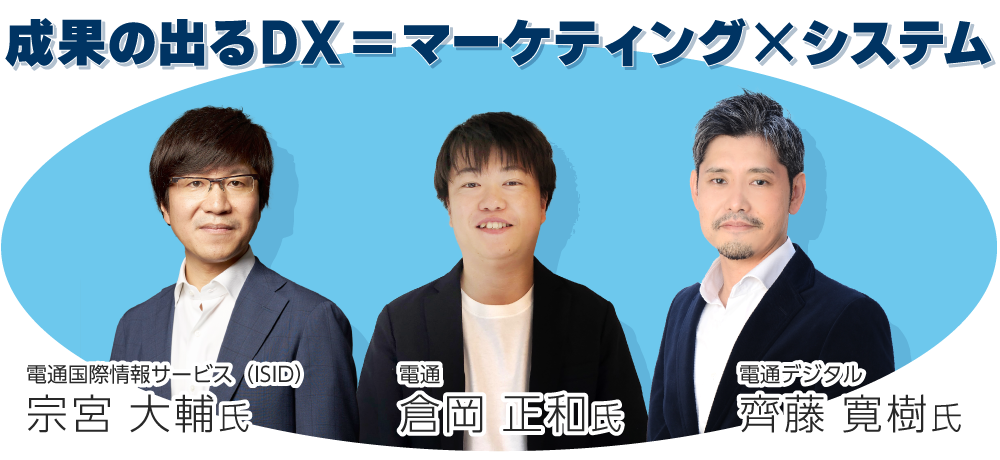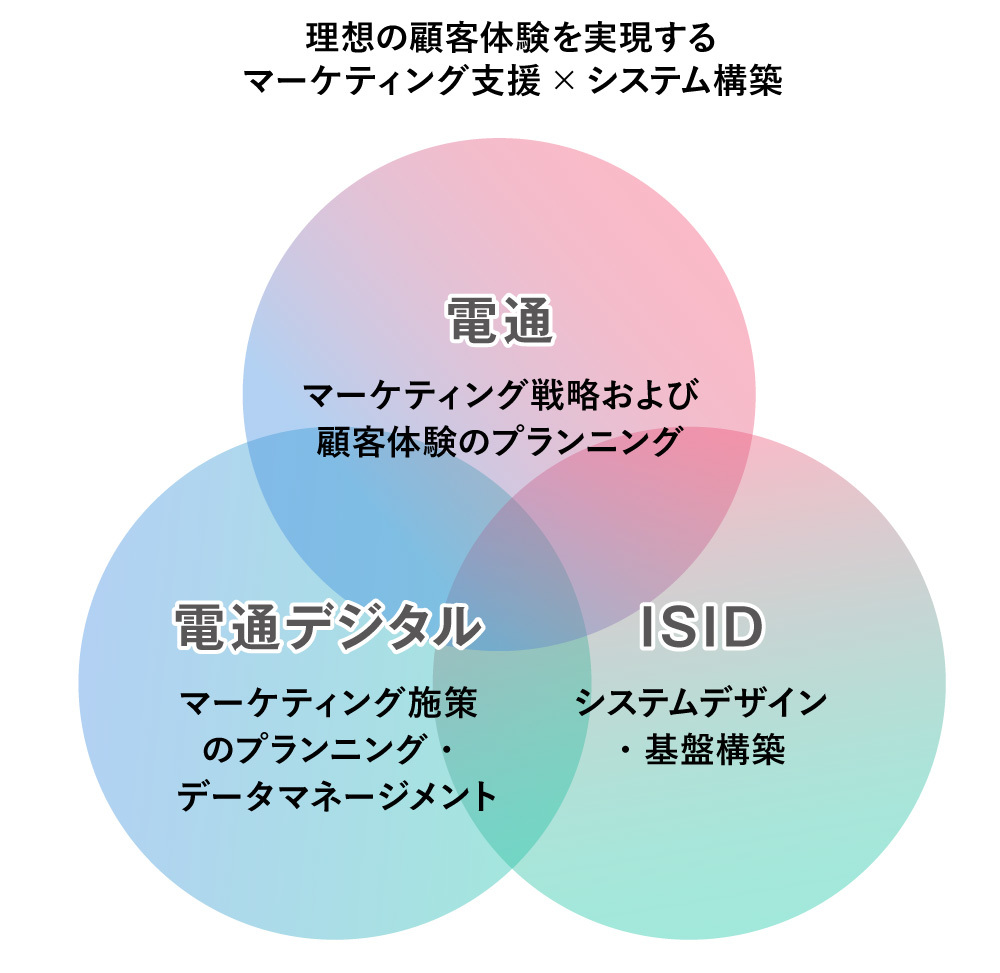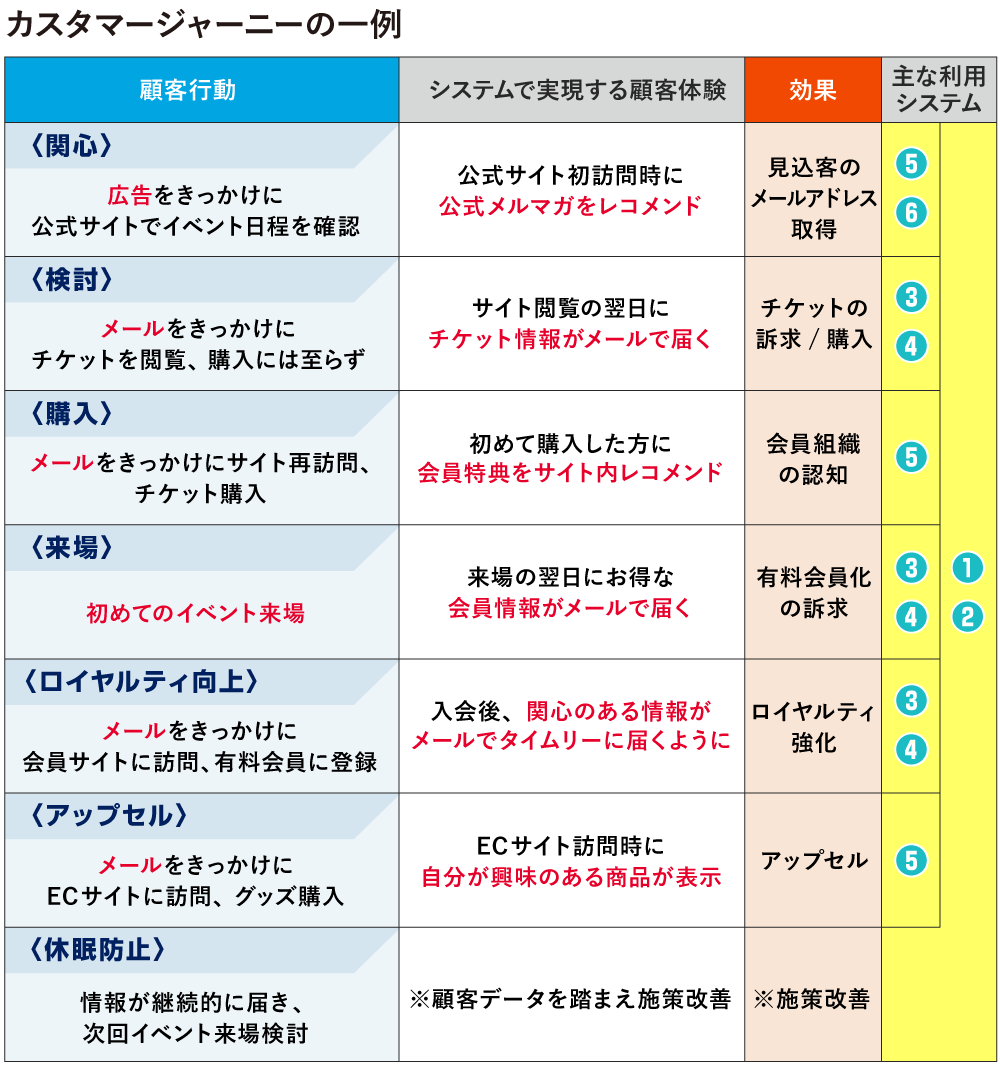Dentsu Inc., Dentsu International Information Services (ISID), and Dentsu Digital Inc. launched the "DX Diagnosis for Systems" solution ( release here ) in June 2021. This solution promotes the implementation of marketing systems to achieve ideal customer experiences.

This solution targets companies seeking to clarify their current DX status and identify next steps, providing a diagnosis and roadmap from both marketing strategy and system perspectives.
- Businesses with a BtoC model that face challenges in customer-facing digital initiatives or utilizing customer data
- Customer touchpoints include e-commerce sites, apps, email, call centers, and physical stores
- Companies that have made some system investments but face challenges due to fragmented system optimization, resulting in an unclear overall picture
In the third article, we covered the background and content of this service. This time, we feature a roundtable discussion with Masakazu Kuraoka from Dentsu Inc., Daisuke Munemiya from ISID, and Hiroki Saito from Dentsu Digital Inc. They discuss the importance of integrating marketing and systems when driving DX.

Dentsu Inc.: Engages in projects that provide an overview of business strategy, marketing strategy, and brand strategy for numerous companies. Possesses not only deep marketing expertise but also broad knowledge of clients' businesses.
ISID: An IT company with a proven track record in building specialized systems across diverse fields including finance, manufacturing, and corporate management. In the marketing domain, it leverages the unique insights of the Dentsu Group to develop and provide services/solutions.
Dentsu Digital Inc.: Starting with services integrating digital advertising and CRM (Customer Relationship Management), it now provides services across all digital domains. This includes proposing business model transformations and optimal marketing systems/data environments based on "people and data." Leveraging its strengths in marketing conceptualization, operational execution, and cross-domain integration, it supports corporate DX through a one-stop system.
Developed through collaboration of three companies with expertise in both marketing and systems
──Please explain each company's role in developing "DX Diagnosis for Systems".
Kuraoka: Dentsu Inc.'s role was to consider, from a business-oriented perspective, what kind of business and marketing strategy the client has and what kind of system is necessary to achieve it. A strength is that for clients we have ongoing business relationships with and whose business and marketing strategies we understand, we can conduct the diagnosis in collaboration with our internal client-dedicated team.
Muneomi: ISID is valued for its ability to build systems, including project management, and its expertise in marketing solutions. While our ability to handle the entire process is an advantage, our main role in developing this "DX Diagnosis for Systems" was designing systems for implementing marketing DX.
Saito: Dentsu Digital Inc. primarily handles marketing strategy planning and data management using AI and machine learning. Marketing systems aren't finished once built; ongoing "always on" operation post-implementation is crucial. Our strength lies in our agile approach, which allows us to comprehensively address the current system status and propose ways to grow the business.
Muneomi: One advantage of this collaboration among three Dentsu Group companies is our ability to work together with mutual understanding. For example, Saito-san is proficient in both systems and marketing, while Kuraoka-san has a strong business perspective and deep system knowledge. It's not purely specialized roles; each of us possesses the necessary expertise in both areas for diagnostics, and this shared understanding is a definite plus.

The trap of "first tool implementation" in DX acceleration. Diagnosis that bridges systems advancing individual optimization.
──What perspectives did you particularly prioritize during development?
Kuraoka: As Mr. Saito mentioned earlier, marketing systems fundamentally require continuous refinement after implementation. What truly benefits clients is a system that delivers tangible business results.
Considering this, diagnosing a system without a marketing perspective won't lead to good results or proposals. Therefore, we developed "DX Diagnosis for Systems" with the premise of driving the system's PDCA cycle, grounded in the client's business and marketing strategy.
Saito: Another challenge is that, as DX initiatives accelerate, more companies are making tool implementation their primary goal. This leads to individual departments introducing their own tools, resulting in silos and fragmented systems. For example, Department A and Department B might implement separate systems with identical functions. Later, when they try to share data or integrate systems, they find it impossible because the tools and specifications differ. This can negatively impact the customer experience.
M uneya: Therefore, we believed it was crucial for both the client's marketing and systems departments to gain a thorough understanding of their company's system status through diagnosis and reach mutual agreement. While the importance of DX increases the specialization of these two departments, the organizational boundaries become very blurred when driving and accelerating DX. We also prioritized creating a solution that could bridge the gap between departments through diagnosis.
Starting small and implementing incremental improvements is key to building a marketing system
──Would you say the strengths and key points of the "DX Diagnosis for Systems" itself align with the development perspective?
Kuraoka: We see our advantage in balancing both marketing and systems perspectives to propose concrete, customer-specific initiatives. For example, this solution presents customer journeys as one output of the diagnostic results.
Saito: The purpose of presenting the customer journey is to align with the perspective of each company's "customers"—meaning general consumers—and build a system that enables optimal communication with them. To achieve this, we considered it crucial that the diagnostic process helps clients establish a shared understanding of who their own "customers" are.
Furthermore, in terms of driving the PDCA cycle, another key point is that we employ agile thinking to accelerate the process from diagnostic results to the execution of subsequent measures.
Muneomi: As an output for system development after the diagnosis, we prepare a schedule hypothesis. There, too, we propose incremental growth steps based on agile thinking.


Saito: The marketing domain sees new tools emerging constantly. It's fundamentally different from core systems where you spend three years planning before finally starting development. We need to continuously incorporate evolving technology into development and improvement efforts.
Muneomi: Exactly. Marketing systems achieve results through an approach that starts small, builds customer experiences, and prioritizes improvements in areas showing effectiveness. Our development scenarios also emphasize this kind of "scalability" when delivering diagnostic results.
Supported by a single-team approach combining "Corporate Business Understanding" × "Extensive System Expertise"! Fighters Sports & Entertainment Case Study
──I understand Fighters Sports & Entertainment has already undergone this diagnostic. What was their reaction and feedback?
Kuraoka: For Fighters Sports & Entertainment, both the marketing and information systems departments underwent the diagnosis. Regarding the challenges that prompted the diagnosis, we received comments like the following:
For the team, the fan club, ticket sales, and merchandise sales are crucial business elements. To support these, they introduced a DMP (Data Management Platform) and BI tools five years ago. While data was accumulated in multiple databases and consolidated into the DMP, they felt the challenge was that the data management and analysis framework wasn't designed for rapid PDCA cycles.
Specifically, operations became complex because we had to manually connect data locally each time we needed to send emails or perform analysis. This led to risks associated with manual data processing tasks and the need to request data extraction from external vendors, resulting in an inefficient state (Fighter Sports & Entertainment representative).
Undergoing the "DX Diagnosis for Systems" provided both departments an opportunity to objectively evaluate this system and understand their "current position." When asked about the insights gained through the diagnosis, we received the following positive feedback:
We received an objective assessment of our data utilization status, particularly focusing on data management via the DMP, which had been problematic. This allowed us to reaffirm our current position within the marketing system landscape.
The six diagnostic results provided concrete system improvement proposals, development step hypotheses, a rough budget estimate, and a system configuration vision considering the team's future, which was also helpful for formulating our future implementation plan. It was a great help that Dentsu Inc., who understands the team and its surrounding businesses, and ISID, with their extensive system expertise, worked together as one team. (Fighter Sports & Entertainment Representative)
──You mentioned Dentsu Inc.'s understanding of the company's business strategy. Were there other positive aspects you felt from this case?
Kuraoka: The core is what customer experience we deliver using the system, so both departments involved in the diagnosis need to thoroughly discuss that. By presenting the customer journey mentioned earlier alongside the diagnosis results, I felt both sides gained a deeper understanding of the findings.
Muneomi: Even with system upgrades, it's common to lose sight of the goal midway and end up focusing solely on "the importance of renewal." This time, I was responsible for explaining the diagnostic results, and I think it was beneficial that we progressed without losing sight of the starting point: "We're doing this to achieve this customer experience."
※1 BI (Business Intelligence)
A methodology and technology that combines business analysis, data tools, and best practices to support organizations in making more data-driven management decisions.
We aim to flexibly support compliance with the revised Personal Information Protection Act and companies without existing systems.
──Please share your outlook for the future.
Saito: As a group, we aim to advance diagnostics while considering the cookie-free trend and future connections with mega-platform advertisers (data clean rooms). Integrating these effectively into marketing strategies will further enhance data value and lead to systems that are truly useful for clients.
Kuraoka: The "DX Diagnosis for Systems" has no industry restrictions.
Recently, even national companies have established specialized DX promotion organizations. We can certainly assist members of such organizations who are unclear about their company's marketing infrastructure status, companies concerned about the impact and constraints on marketing systems due to the revised Personal Information Protection Act scheduled for April 2022, or those looking to build/introduce systems and need support with creating RFPs (Request for Proposals). Please feel free to consult with us.
※2 Cookie-Free
Refers to the trend of restricting the collection and use of information via "cookies"—which store website browsing history in browsers—from a personal information protection perspective.
※3 Data Clean Room
A data infrastructure enabling continuous marketing PDCA cycles while protecting privacy. Companies can access data for integration and analysis without identifying individual consumers.
※4 RFP (Request for Proposal)
A document issued by the client to system vendors or developers during system evaluation or implementation. It outlines the system's scope, required technical specifications, desired business functions, and delivery deadlines.













